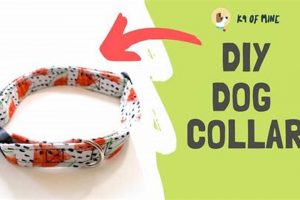Creating customized edible rewards for canine behavioral modification offers numerous advantages. These homemade incentives, prepared with specific ingredients and portion sizes, facilitate focused and effective learning. For instance, small, soft bites made from cooked chicken and sweet potato are readily accepted and easily consumed during training sessions, minimizing distractions.
Utilizing this method promotes a healthier, cost-effective approach to positive reinforcement. Owners gain precise control over the ingredients, eliminating artificial additives and potential allergens commonly found in commercially produced options. Historically, the practice of using food as a motivator dates back to early animal domestication, evolving into sophisticated behavioral training techniques. The ability to tailor the composition allows for addressing specific dietary needs or preferences, further enhancing its appeal.
The following sections will detail practical recipes, safety considerations, and strategies for integrating these personalized rewards into various training protocols, ultimately leading to a stronger bond and improved obedience.
Guidance on Homemade Canine Incentive Preparation
The following outlines crucial considerations for producing effective and safe homemade canine incentives. Adherence to these guidelines optimizes the training process and ensures the well-being of the animal.
Tip 1: Ingredient Selection:Prioritize high-quality, canine-safe ingredients. Avoid toxic substances such as chocolate, grapes, onions, and artificial sweeteners. Lean meats, vegetables like carrots and sweet potatoes, and whole grains represent suitable components.
Tip 2: Portion Control:Maintain minimal size to prevent overfeeding. Ideal dimensions are approximately pea-sized, facilitating rapid consumption and minimizing distractions during training exercises.
Tip 3: Texture Considerations: Aim for a soft, easily chewable consistency. This feature ensures rapid ingestion and prevents choking hazards, especially for smaller breeds or puppies. Baking or dehydration methods can achieve the desired texture.
Tip 4: Allergen Awareness: Identify and exclude potential allergens if the canine exhibits sensitivities. Common allergens include wheat, soy, and dairy. Substituting with hypoallergenic alternatives, such as rice flour or limited-ingredient protein sources, is advisable.
Tip 5: Storage Practices: Employ appropriate storage methods to maintain freshness and prevent spoilage. Refrigeration or freezing extends the shelf life of perishable ingredients. Airtight containers minimize moisture exposure and maintain palatability.
Tip 6: Gradual Introduction: Introduce new recipes gradually to monitor for adverse reactions. Observe the canine for signs of digestive upset or allergic responses following initial consumption.
Tip 7: Nutritional Balance: Recognize that these items supplement, not replace, a balanced diet. Adjust the canine’s daily food ration to account for caloric intake from training incentives, preventing weight gain.
Adhering to these preparation strategies maximizes the effectiveness and safety of utilizing homemade canine incentives, contributing to successful behavioral modification.
The subsequent sections will explore specific recipes and strategies for incorporating these tailored incentives into a comprehensive training regimen.
1. Ingredients' Safety
The selection of appropriate and safe ingredients constitutes a foundational element in the preparation of customized canine rewards. The potential for adverse health consequences necessitates a meticulous approach to ingredient sourcing and handling, impacting the overall efficacy and ethical considerations of utilizing edible incentives in behavioral training.
- Avoidance of Toxic Substances
Certain substances, innocuous to humans, present significant hazards to canines. Chocolate, containing theobromine, causes cardiovascular and neurological damage. Xylitol, an artificial sweetener, induces rapid insulin release, leading to hypoglycemia and liver failure. Grapes and raisins can cause kidney failure. These necessitate complete exclusion from homemade recipes.
- Allergen Identification and Management
Canine food allergies are prevalent, manifesting as dermatological or gastrointestinal distress. Common allergens include wheat, soy, corn, and certain proteins. Careful monitoring and elimination of suspected allergens, often through limited-ingredient diets, are crucial for safeguarding the animal’s well-being. Substitute ingredients such as rice flour or novel proteins (duck, venison) must be considered.
- Ingredient Sourcing and Handling
The origin and processing of raw materials influence safety. Locally sourced, organic produce minimizes exposure to pesticides and herbicides. Thorough washing of fruits and vegetables removes surface contaminants. Meat should be cooked to appropriate internal temperatures to eliminate bacterial pathogens. Proper hygiene and sanitation practices during preparation are mandatory to prevent contamination.
- Potential for Additives and Preservatives
Many commercial canine edibles contain artificial additives, colorings, and preservatives that may induce adverse reactions or long-term health risks. Homemade options offer precise control over ingredient composition, allowing for the exclusion of potentially harmful substances. The inclusion of natural preservatives, such as Vitamin E or rosemary extract, can extend shelf life without compromising safety.
The responsible formulation of canine rewards necessitates a comprehensive understanding of potential hazards and preventative measures. Adherence to stringent safety protocols minimizes risks, fostering a training environment conducive to both behavioral modification and the maintenance of canine health and welfare. Neglecting the crucial aspect of ingredients’ safety directly undermines the intended benefits of customized edible incentives.
2. Portion Size
The calibration of edible reward dimensions represents a critical factor in the successful application of personalized canine incentives. Improperly sized rewards can undermine training efficacy, compromise dietary balance, and negatively affect the animal’s focus and motivation.
- Minimizing Satiety Disruption
Oversized treats induce premature satiety, diminishing the dog’s motivation to perform desired behaviors. The canine’s focus shifts from task engagement to digestive processes, reducing the effectiveness of reinforcement. Ideal dimensions approximate pea-sized portions, sufficient for taste and olfactory stimulation without causing significant caloric intake.
- Caloric Control and Weight Management
Excessive caloric intake from training incentives contributes to weight gain and associated health problems. A precise quantification of caloric content per portion is imperative. Adjustments to the canine’s daily food ration must compensate for the additional calories consumed during training, preventing imbalances in energy intake and expenditure.
- Rapid Consumption and Task Focus
Large treats require prolonged chewing, interrupting the flow of training exercises and diverting attention from the handler’s instructions. Smaller, easily consumable portions facilitate rapid ingestion, allowing for immediate reinforcement and minimizing distractions. This streamlined process enhances learning efficiency and maintains the canine’s engagement.
- Breed-Specific Considerations
Optimal portion sizes vary according to breed, age, and metabolic rate. Smaller breeds and puppies require proportionally smaller treats to prevent choking hazards and digestive distress. Adjustments to dimensions must consider individual animal characteristics, ensuring safe and effective reward delivery across diverse canine populations.
Precise attention to portion size optimizes the effectiveness and health benefits of custom canine rewards. Consistent application of appropriate dimensions promotes sustained motivation, facilitates caloric control, and ensures seamless integration into training protocols, solidifying positive associations and reinforcing desired behaviors without compromising dietary integrity.
3. Texture Consistency
The textural properties of customized canine edibles significantly influence their acceptance and utility within training paradigms. Uniformity in texture ensures predictable consumption patterns and minimizes potential distractions during reinforcement exercises.
- Palatability and Acceptance
Canines exhibit preferences for specific textures. A dry, crumbly incentive might be less appealing than a moist, pliable alternative. Tailoring the texture to align with individual preferences increases the likelihood of enthusiastic acceptance and strengthens the positive association with the rewarded behavior. An easily chewed texture is generally preferred.
- Swallowing Ease and Safety
A consistent texture minimizes the risk of choking, particularly in smaller breeds or puppies. Overly hard or irregularly shaped incentives present a potential hazard. A uniform, easily deformable texture ensures safe consumption and prevents disruptions to the training process. Softer consistencies are easier for dogs to manage.
- Digestive Impact
Variations in texture can affect digestive processing. Inconsistencies might lead to digestive upset in some animals. Maintaining a consistent, easily digestible texture promotes optimal nutrient absorption and reduces the likelihood of gastrointestinal disturbances. A smooth texture is generally considered gentle on the digestive system.
- Dispensing Efficiency
Certain training aids, such as treat-dispensing toys, require specific textural attributes for optimal functionality. A consistent, easily dispensed texture ensures reliable release of the reward, maintaining the flow of training and preventing frustration for both the handler and the canine. The consistency should allow for smooth and predictable dispensing.
The aforementioned facets illustrate the critical role of textural consistency in the design and preparation of customized canine rewards. Attention to these parameters optimizes palatability, ensures safety, promotes digestive health, and enhances training efficacy. Neglecting texture considerations can undermine the intended benefits of customized incentives and potentially compromise the well-being of the animal. A well-designed treat considers all factors.
4. Nutritional Value
The nutritional composition of canine rewards is a paramount consideration when formulating homemade incentives. Imbalances or deficiencies can adversely affect the animal’s health and undermine the positive reinforcement principles underlying behavioral training. A focus on optimizing nutritional content ensures both effective training and sustained well-being.
- Macronutrient Balance
Canines require a specific ratio of proteins, carbohydrates, and fats. Protein supports muscle development and repair, carbohydrates provide energy, and fats contribute to hormone production and nutrient absorption. The relative proportions of these macronutrients must align with the canine’s life stage, activity level, and overall health status. Homemade rewards should supplement, not disrupt, the existing macronutrient balance provided by the animal’s primary diet. Example: A highly active dog may benefit from treats with a higher protein content.
- Micronutrient Inclusion
Vitamins and minerals play vital roles in various physiological processes. Deficiencies can manifest as weakened immune systems, impaired cognitive function, or skeletal abnormalities. Incorporating nutrient-rich ingredients, such as fruits and vegetables, into homemade recipes can contribute to micronutrient adequacy. Example: Sweet potatoes provide Vitamin A, crucial for vision and immune function.
- Digestibility and Bioavailability
The nutritional value of an ingredient is contingent upon its digestibility and bioavailability. Certain compounds, while present, may not be readily absorbed or utilized by the canine’s digestive system. Selecting ingredients with high digestibility and minimal processing enhances nutrient assimilation. Example: Cooked meats are more easily digested than raw meats.
- Minimizing Empty Calories
Excessive consumption of treats lacking essential nutrients contributes to weight gain without providing tangible health benefits. “Empty calories” should be minimized by prioritizing whole, unprocessed ingredients. Example: Replacing refined flours with whole-grain alternatives increases the fiber content and nutritional density of the reward.
The facets of macronutrient balance, micronutrient inclusion, digestibility, and the reduction of empty calories collectively define the nutritional value of canine incentives. Thoughtful consideration of these elements ensures that homemade rewards not only motivate desired behaviors but also contribute to the sustained health and vitality of the animal, aligning training practices with responsible animal care. Improper treat nutrition impacts training negatively.
5. Storage Methods
Effective preservation techniques are crucial for maintaining the quality and safety of homemade canine incentives. Improper storage degrades palatability, promotes microbial growth, and diminishes nutritional value, negating the intended benefits of customized edibles.
- Temperature Control
Refrigeration and freezing significantly inhibit bacterial proliferation and enzymatic degradation. Perishable treats, particularly those containing meat or dairy, require consistent refrigeration to prevent spoilage. Freezing extends shelf life, but may alter texture upon thawing. For example, small batches stored in airtight containers in the freezer can last for several weeks, while unrefrigerated options may degrade within hours.
- Airtight Containment
Exposure to atmospheric oxygen accelerates oxidation and promotes moisture absorption, leading to rancidity and microbial contamination. Airtight containers, such as resealable bags or sealed jars, minimize oxygen exposure and maintain dryness. Desiccants, like silica gel packets, can further reduce moisture levels. Vacuum sealing represents an advanced preservation method.
- Light Protection
Exposure to light, particularly ultraviolet radiation, can degrade light-sensitive vitamins and accelerate lipid oxidation. Opaque or tinted containers provide a protective barrier against light-induced degradation. Storage in dark, cool environments further minimizes light exposure and preserves nutritional integrity.
- Labeling and Dating
Clear labeling with preparation and expiration dates is essential for tracking storage duration and ensuring safe consumption. Date marking prevents accidental consumption of expired treats, mitigating the risk of foodborne illness. A system for rotating stock, using older batches before newer ones, maximizes shelf life and minimizes waste.
The application of temperature control, airtight containment, light protection, and detailed labeling protocols is paramount for preserving the integrity of homemade canine rewards. Proper storage practices guarantee that these incentives retain their palatability, nutritional value, and safety, thereby contributing to effective and responsible canine training.
6. Dog's Preferences
The customization of canine incentives is predicated upon a thorough understanding of individual palatability preferences. This knowledge ensures that the rewards employed effectively motivate the animal and contribute to successful training outcomes. Ignoring these preferences diminishes the efficacy of positive reinforcement strategies.
- Flavor Profiles and Acceptance Rates
Canines exhibit distinct flavor preferences, analogous to human taste preferences. Some individuals may favor meat-based flavors, such as chicken or beef, while others show greater affinity for vegetable-derived flavors, like sweet potato or carrot. Acceptance rates can vary significantly across individuals and breeds. Careful observation of the animal’s response to different flavor profiles informs the selection of appropriate ingredients for homemade incentives, thereby optimizing reward value.
- Textural Affinities and Consumption Patterns
Beyond flavor, textural characteristics influence a canine’s acceptance of edible rewards. Some individuals prefer soft, easily chewed treats, while others favor crunchy or chewy options. Textural preferences often correlate with breed characteristics, dental health, and age. Aligning the texture of homemade incentives with the animal’s established affinities promotes rapid consumption and minimizes distractions during training sessions.
- Scent Recognition and Olfactory Stimulation
Canines possess highly developed olfactory senses, significantly impacting their perception of food. Aromatic compounds play a crucial role in stimulating appetite and enhancing reward value. Incorporation of potent, canine-appealing scents, such as liver or cheese, into homemade recipes can increase the effectiveness of training incentives, particularly in distracting environments. Attention to olfactory stimulation can be a critical factor in a dog’s treat preference.
- Neophobia and Ingredient Introduction
Canines may exhibit neophobia, a reluctance to consume unfamiliar foods. Gradual introduction of new ingredients is essential for mitigating this aversion and expanding the repertoire of acceptable reward options. Introducing new flavors and textures in small quantities, alongside familiar ingredients, increases the likelihood of acceptance and prevents digestive upset. Patience is required when introducing novel ingredients.
The interplay between flavor, texture, scent, and novelty dictates a canine’s preference for specific edible rewards. Customized preparation, incorporating these parameters, maximizes the motivational impact of homemade incentives and contributes to successful behavioral modification. Ignoring such individual preferences drastically undermines the potential of diy dog training treats.
7. Training Integration
The effective application of customized canine edibles hinges upon seamless integration within established training methodologies. The selection, timing, and delivery of these incentives must align with specific behavioral goals to maximize reinforcement and accelerate learning. The lack of a cohesive integration strategy diminishes the utility of even the most palatable and nutritious homemade rewards.
- Timing and Contingency
The immediacy of reward delivery is paramount for establishing a clear association between the desired behavior and the positive reinforcement. Treats must be presented within a narrow temporal window (ideally, within 0.5-1 second) following the execution of the target behavior. Delayed or inconsistent delivery weakens the association and hinders learning. For example, delivering a treat several seconds after a dog sits will be less effective than delivering it immediately upon the dog’s rear touching the ground.
- Shaping and Gradual Approximation
Complex behaviors are often acquired through shaping, a process of reinforcing successive approximations of the desired outcome. Homemade treats are particularly well-suited for shaping, as the size and palatability can be adjusted to maintain the dog’s motivation throughout the training sequence. For instance, a larger or more appealing treat might be used to reward the initial approximations, while smaller, less exciting rewards are used for refining the final behavior.
- Variable Ratio Reinforcement
Once a behavior is reliably established, transitioning to a variable ratio reinforcement schedule enhances its durability and resistance to extinction. Variable ratio schedules involve delivering rewards intermittently, unpredictably varying the number of responses required for reinforcement. This approach increases the dog’s motivation to perform the behavior consistently, even in the absence of immediate rewards. Homemade treats facilitate fine-tuning of reinforcement schedules, enabling gradual and controlled progression towards more advanced training goals.
- Contextual Consistency and Cueing
The environment in which training occurs can influence the dog’s performance. Establishing consistent cues and training contexts promotes generalization of learned behaviors. Using the same homemade treats, delivered in a consistent manner, across diverse settings helps the dog associate the desired behavior with the corresponding cue, regardless of the surrounding environment. For instance, using a specific treat only during recall training can create a strong association between the treat and coming when called.
These considerations underscore the critical link between bespoke edible incentives and structured training protocols. Optimized diy dog training treats not only provide nutritional support and flavor appeal but are also indispensable tools for shaping canine behavior through precise application of learning principles. Neglecting integration aspects greatly reduced training benefits.
Frequently Asked Questions
This section addresses common inquiries regarding the preparation and utilization of homemade edible rewards for canine training. The responses aim to provide clear and concise information based on established veterinary and behavioral science principles.
Question 1: Is it safe to prepare edible rewards at home?
Homemade canine incentives can be safe if prepared with canine-appropriate ingredients, avoiding toxic substances like chocolate, onions, and xylitol. Adherence to proper food handling and storage protocols is essential. Consultation with a veterinarian is recommended to address specific dietary concerns or allergies.
Question 2: How should portion sizes be determined?
Portion sizes should be minimized to prevent overfeeding and maintain focus during training. Ideal dimensions are approximately pea-sized. Caloric intake from these incentives should be factored into the canine’s daily dietary allowance. Adjustments are necessary based on breed, age, and activity level.
Question 3: What are some suitable ingredients for training rewards?
Lean meats (chicken, turkey), vegetables (carrots, sweet potatoes), and whole grains (oats, brown rice) constitute appropriate ingredients. Ingredients should be free from artificial additives, preservatives, and potential allergens. Cooking methods should prioritize nutritional preservation.
Question 4: How should homemade incentives be stored?
Homemade incentives should be stored in airtight containers to prevent moisture absorption and oxidation. Refrigeration or freezing extends shelf life. Perishable items require refrigeration. Clear labeling with preparation and expiration dates is essential to ensure safe consumption.
Question 5: Can homemade options replace a complete and balanced canine diet?
Homemade incentives should supplement, not replace, a complete and balanced canine diet. These treats are intended for training purposes and should not constitute a significant portion of the animal’s daily caloric intake. A commercially available, nutritionally complete food should form the basis of the canine’s diet.
Question 6: How can individual canine preferences be identified?
Individual preferences can be determined through observation and experimentation. Introducing small quantities of different flavors and textures allows for identifying preferred options. Monitoring the canine’s response (enthusiasm, consumption speed) provides valuable insights into palatability preferences.
The information presented in this FAQ section provides general guidance. Specific concerns should be addressed in consultation with a qualified veterinary professional. Careful attention to safety and nutritional considerations optimizes the benefits of diy dog training treats.
The subsequent section will explore specific recipes and practical considerations for integrating customized incentives into training regimens.
Concluding Observations on Canine Reward Customization
This exploration of diy dog training treats has illuminated the intricate considerations necessary for safe and effective implementation. Key elements such as ingredient safety, portion control, texture consistency, nutritional value, storage methods, and preference elicitation significantly impact the success of any training endeavor. Proper integration of these factors is crucial for optimizing canine motivation and accelerating learning processes.
The informed and responsible application of these principles will contribute significantly to enhanced training outcomes and improved canine well-being. Continued research and refinement of these methods hold promise for even greater advances in canine behavioral modification. Responsible and diligent effort in this area fosters a deeper connection and a more harmonious relationship between canines and their human companions.







